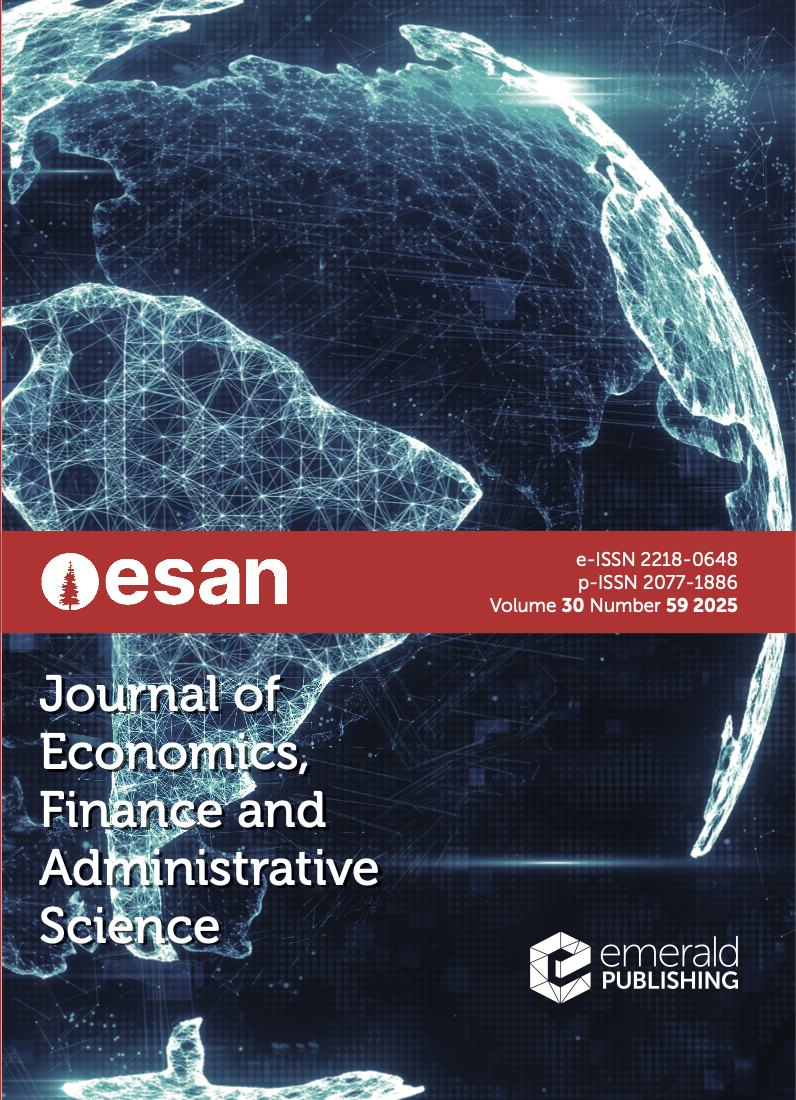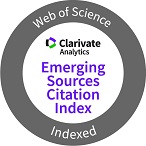Taking ESG strategies for achieving profits: a dynamic panel data analysis
Keywords:
ESG, Corporate social responsibility, Financial performance, Dynamic data panel, Developing marketsAbstract
PurposeThe goal is to investigate the relationship between financial performance and environmental, social and governance (ESG) indicators and disclosures for a sample of Latin American firms.
Design/methodology/approachDynamic panel data regressions are used to analyze a sample of 114 companies listed on the Latin American Integrated Market, MILA (Chile, Colombia, Mexico and Peru) for the period 2011–2020. The Altman Z-score and Piotroski F-score are used as indicators of the probability of default and comprehensive financial strength. Models are developed in which the relationship between economic value added (EVA) and Jensen’s alpha are evaluated against firms’ ESG practices.
FindingsA direct relationship between ESG strategies and financial performance was found. Better practices and transparency in ESG are related to lower probability of bankruptcy, greater financial strength, greater EVA and superior risk-adjusted returns.
Research limitations/implicationsESG data were obtained from the Bloomberg system based on a methodology that may differ from other sources. The sample covers four Latin American countries and large corporations. Independent variables were selected for their perceived validity, given their frequent use in previous studies.
Practical implicationsEvidence for company management regarding the importance of strengthening ESG practices and reporting should be part of their balanced scorecards. For investors, the results support the importance of evaluating ESG practices in asset selection.
Originality/valueThe present study is the first research to present empirical evidence on the relationship between ESG scores and disclosures for MILA countries, using a comprehensive set of financial performance indicators (Altman Z-scores, Piotroski F-scores, EVA and Jensen’s alpha).
Downloads
References
Altman, E.I. (1968), “Financial ratios, discriminant analysis and the prediction of corporate bankruptcy”, The Journal of Finance, Vol. 23 No. 4, pp. 589-609, doi: 10.1111/j.1540-6261.1968.tb00843.x.
Altman, E.I. (2013), “Predicting financial distress of companies: revisiting the Z- Score and ZETA® models”, in Bell, A.R., Brooks, C. and Prokopczuk, M. (Eds), Handbook of Research Methods and Applications in Empirical Finance, Edward Elgar Publishing, pp. 428-456.
Altman, E.I., Haldeman, R.G. and Narayanan, P. (1977), “ZETATM analysis: a new model to identify bankruptcy risk of corporations”, Journal of Banking and Finance, Vol. 1 No. 1, pp. 29-54, doi: 10.1016/0378-4266(77)90017-6.
Arellano, M. and Bond, S. (1991), “Some tests of specification for panel data: Monte Carlo evidence and an application to employment equations”, The Review of Economic Studies, Vol. 58 No. 2, pp. 277-297, doi: 10.2307/2297968.
Atan, R., Alam, M.M., Said, J. and Zamri, M. (2018), “The impacts of environmental, social, and governance factors on firm performance. Panel study of Malaysian companies”, Management of Environmental Quality: An International Journal, Vol. 29 No. 2, pp. 182-194, doi: 10.1108/MEQ-03-2017-0033.
Barnett, M.L. and Salomon, R.M. (2012), “Does it pay to be really good? Addressing the shape of the relationship between social and financial performance”, Strategic Management Journal, Vol. 33 No. 11, pp. 1304-1320, doi: 10.1002/smj.1980.
Biørn, E. (2017), Econometrics of Panel Data. Methods and Applications, Oxford University Press, Oxford.
Blowfield, M. (2005), “Corporate social responsibility: reinventing the meaning of development?”, International Affairs, Vol. 81 No. 3, pp. 515-524, doi: 10.1111/j.1468-2346.2005.00466.x.
Bolton, B. (2015), Sustainable Financial Investments: Maximizing Corporate Profits and Long-Term Economic Value Creation, Palgrave Macmillan, New York, NY.
Buallay, A. (2019), “Between cost and value. Investigating the effects of sustainability reporting on a firm's performance”, Journal of Applied Accounting Research, Vol. 20 No. 4, pp. 481-496, doi: 10.1108/JAAR-12-2017-0137.
Carroll, A.B. (1979), “A three-dimensional conceptual model of corporate social performance”, Academy of Management Review, Vol. 4, pp. 497-505, doi: 10.2307/257850.
Cherkasova, V., Fedorova, E. and Stepnov, I. (2023), “Market reaction to firms' investments in CSR projects”, Journal of Economics, Finance and Administrative Science, Vol. 28 No. 55, pp. 44-59, doi: 10.1108/JEFAS-08-2021-0150.
Correa-García, J.A. and Vásquez-Arango, L. (2020), “Desempeño ambiental, social y de gobierno (ASG): incidencia en el desempeño financiero en el contexto latinoamericano”, Revista Facultad de Ciencias Económicas, Vol. 28 No. 2, pp. 67-83, doi: 10.18359/rfce.4271.
Croft, T. and Malhotra, A. (2016), The Responsible Investor Handbook: Mobilizing Workers’ Capital for a Sustainable World, Routledge, New York, NY.
Dalal, K.K. and Thaker, N. (2019), “ESG and corporate financial performance: a panel study of Indian companies”, The IUP Journal of Corporate Governance, Vol. XVIII No. 1, pp. 44-59.
Davidson, R. and MacKinnon, J.G. (1993), Estimation and Inference in Econometrics, Oxford University Press, New York, NY.
Derwall, J., Guenster, N., Bauer, R. and Koedijk, K. (2005), “The eco-efficiency premium puzzle”, Financial Analysts Journal, Vol. 61 No. 2, pp. 51-63, doi: 10.2469/faj.v61.n2.2716.
Duque-Grisales, E. and Aguilera-Caracuel, J. (2021), “Environmental, social and governance (ESG) scores and financial performance of multilatinas: moderating effects of geographic international diversification and financial slack”, Journal of Business Ethics, Vol. 168 No. 2, pp. 315-334, doi: 10.1007/s10551-019-04177-w.
Eccles, R.G. and Saltzman, D. (2011), “Achieving sustainability through integrated reporting”, Stanford Social Innovation Review, Vol. 9 No. 3, pp. 56-61, doi: 10.48558/7xs8-mx90.
Eccles, R.G., Ioannou, I. and Serafeim, G. (2014), “The impact of corporate sustainability on organizational processes and performance”, Management Science, Vol. 60 No. 11, pp. 2835-2857, doi: 10.2139/ssrn.1964011.
Eccles, R.G., Krzus, M.P. and Ribot, S. (2015), “Models of best practice in integrated reporting 2015”, The Journal of Applied Corporate Finance, Vol. 27 No. 2, pp. 103-115, doi: 10.1111/jacf.12123.
Fakoya, M.B. and Malatji, S.E. (2020), “Integrating ESG factors in investment decisions by mutual fund managers: a case of selected Johannesburg Stock Exchange-listed companies”, Investment Management and Financial Innovations, Vol. 17 No. 4, pp. 258-270, doi: 10.21511/imfi.17(4).2020.23.
Fatemi, A., Glaum, M. and Kaiser, S. (2018), “ESG performance and firm value: the moderating role of disclosure”, Global Finance Journal, Vol. 38 C, pp. 45-64, doi: 10.1016/j.gfj.2017.03.001.
Freeman, R.E. (1984), Strategic Management: A Stakeholder Approach, Pitman, Boston, MA.
Friede, G., Busch, T. and Bassen, A. (2015), “ESG and financial performance: aggregated evidence from more than 2000 empirical studies”, Journal of Sustainable Finance and Investment, Vol. 5 No. 4, pp. 210-233, doi: 10.1080/20430795.2015.1118917.
Friedman, M. (1970), “The social responsibility of business is to increase its profits”, New York Times Magazine, available at: https://www.nytimes.com/1970/09/13/archives/a-friedman-doctrine-the-social-responsibility-of-business-is-to.html (accessed 22 September 2022).
Garzón-Jiménez, R. and Zorio-Grima, A. (2021), “Sustainability engagement in Latin America firms and cost of equity”, Academia. Revista Latinoamericana de Administración, Vol. 34 No. 2, pp. 224-243, doi: 10.1108/ARLA-05-2020-0117.
Global Sustainable Investment Alliance (2021), “Global sustainable investment review”, available at: http://www.gsi-alliance.org/wp-content/uploads/2021/08/GSIR-20201.pdf (accessed 22 September 2022).
Goss, A. and Roberts, G.S. (2011), “The impact of corporate social responsibility on the cost of bank loans”, Journal of Banking and Finance, Vol. 35 No. 7, pp. 1794-1810, doi: 10.1016/j.jbankfin.2010.12.002.
Greene, W.H. (2019), Econometric Analysis, 8th ed., Pearson, Harlow.
Hillier, D., Pindado, J., de Queiroz, V. and de la Torre, C. (2011), “The impact of country-level corporate governance on research and development”, Journal of International Business Studies, Vol. 42 No. 1, pp. 76-98.
Hyrske, A., Lönnroth, M., Savilaakso, A. and Sievänen, R. (2022), The Responsible Investor. An Introductory Guide to Responsible Investment, Routledge, New York, NY.
Jensen, M.C. (2000), “Value maximization and the corporate objective function”, in Beer, M. and Nohria, N. (Eds), Breaking the Code of Change, HBS Press, pp. 1-21.
Jensen, M.C. (2001), “Value maximization, stakeholder theory, and the corporate objective function”, The Journal of Applied Corporate Finance, Vol. 14 No. 3, pp. 8-21, doi: 10.1111/j.1745-6622.2001.tb00434.x.
Jones, T.M. (1980), “Corporate social responsibility revisited, redefined”, California Management Review, Vol. 22 No. 3, pp. 59-67, doi: 10.2307/41164877.
Landi, G. and Sciarelli, M. (2019), “Towards a more ethical market: the impact of ESG rating on corporate financial performance”, Social Responsibility Journal, Vol. 15 No. 1, pp. 11-27, doi: 10.1108/SRJ-11-2017-0254.
Lavin, J.F. and Montecinos-Pearce, A.A. (2021), “ESG disclosure in an emerging market: an empirical analysis of the influence of board characteristics and ownership structure”, Sustainability, Vol. 13 No. 19, pp. 1-20, doi: 10.3390/su131910498.
Levitt, T. (1958), “The dangers of social responsibility”, Harvard Business Review, Vol. 36, pp. 41-50.
Li, Y., Gong, M., Zhang, X.Y. and Koh, L. (2018), “The impact of environmental, social, and governance disclosure on firm value: the role of CEO power”, The British Accounting Review, Vol. 50 No. 1, pp. 60-75, doi: 10.1016/j.bar.2017.09.007.
Lindgreen, A., Swaen, V. and Johnston, W.J. (2009), “Corporate social responsibility: an empirical investigation of US organizations”, Journal of Business Ethics, Vol. 85 No. S2, pp. 303-323, doi: 10.1007/s10551-008-9738-8.
Madhavan, A., Sobczyk, A. and Ang, A. (2021), “Toward ESG Alpha: analyzing ESG exposures through a factor lens”, Financial Analysts Journal, Vol. 77 No. 1, pp. 69-88, doi: 10.1080/0015198X.2020.1816366.
Maignan, I. and Ferrell, O.C. (2001), “Antecedents and benefits of corporate citizenship: an investigation of French businesses”, Journal of Business Research, Vol. 51 No. 1, pp. 37-51, doi: 10.1016/S0148-2963(99)00042-9.
Martínez-Ferrero, J. (2014), “Consecuencias de las prácticas de sostenibilidad en el coste de capital y en la reputación corporativa”, Revista de Contabilidad, Vol. 17 No. 2, pp. 153-162, doi: 10.1016/j.rcsar.2013.08.008.
Martínez-Ferrero, J. and Frías-Aceituno, J.V. (2015), “Relationship between sustainable development and financial performance: international empirical research”, Business Strategy and the Environment, Vol. 24 No. 1, pp. 20-39, doi: 10.1002/bse.1803.
Mayo, H.B. (2011), Investments, 10th ed., Cengage Learning, Mason, OH.
Ooi, E. and Lajbcygier, P. (2013), “Virtue remains after removing sin: finding skill amongst socially responsible investment managers”, Journal of Business Ethics, Vol. 113 No. 2, pp. 199-224, doi: 10.1007/s10551-012-1290-x.
Pesaran, M.H. (2015), Time Series and Panel Data Econometrics, Oxford University Press, Oxford.
Peterdy, K. (2023), ESG Disclosure, Corporate Finance Institute, available at: https://corporatefinanceinstitute.com/resources/esg/esg-disclosure/ (accessed 15 May 2024).
Piotroski, J.D. (2000), “Value investing: the use of historical financial statement information to separate winners from losers”, Journal of Accounting Research, Vol. 38, pp. 1-41, doi: 10.2307/2672906.
Ramírez, A.G., Monsalve, J., González-Ruiz, J.D., Almonacid, P. and Peña, A. (2022), “Relationship between the cost of capital and environmental, social, and governance scores: evidence from Latin America”, Sustainability, Vol. 14 No. 9, pp. 1-15, doi: 10.3390/su14095012.
Rodríguez-García, M.P., Galindo-Manrique, A.F., Cortez-Alejandro, K.A. and Méndez-Sáenz, A.B. (2022), “Eco-efficiency and financial performance in Latin American countries: an environmental intensity approach”, Research in International Business and Finance, Vol. 59, pp. 1-10, doi: 10.1016/j.ribaf.2021.101547.
Roodman, D. (2009), “How to do xtabond2: An introduction to difference and system GMM in Stata”, The Stata Journal, Vol. 9 No. 1, pp. 86-136.
Sharpe, W.F. (1964), “Capital asset prices: a theory of market equilibrium under conditions of risk”, The Journal of Finance, Vol. 19 No. 3, pp. 425-442, doi: 10.1111/j.1540-6261.1964.tb02865.x.
Sherwood, M.W. and Pollard, J. (2023), Responsible Investing, 2nd ed., Routledge, New York, NY.
Stern, J.M. and Shiely, J.S. (2001), The EVA Challenge: Implementing Value-Added Change in an Organization, John Wiley & Sons, New York, NY.
Valor, C. (2005), “Corporate social responsibility and corporate citizenship: towards corporate accountability”, Business and Society Review, Vol. 110 No. 2, pp. 191-212, doi: 10.1111/j.0045-3609.2005.00011.x.
Van der Laan, G., Van Ees, H. and Van Witteloostuijn, A. (2008), “Corporate social and financial performance: an extended stakeholder theory, and empirical test with accounting measures”, Journal of Business Ethics, Vol. 79 No. 3, pp. 299-310, doi: 10.1007/s10551-007-9398-0.
Villarón-Peramato, O., García-Sánchez, I. and Martínez-Ferrero, J. (2018), “Capital structure as a control mechanism of a CSR entrenchment strategy”, European Business Review, Vol. 30 No. 3, pp. 340-371, doi: 10.1108/EBR-03-2017-0056.
Visser, W. (2008), “Corporate social responsibility in developing countries”, in Crane, A., McWilliams, A., Matten, D., Moon, J. and Siegel, D. (Eds), The Oxford Handbook of Corporate Social Responsibility, Oxford University Press, pp. 473-479.
Waddock, S.A. and Graves, S.B. (1997), “The corporate social performance-financial performance link”, Strategic Management Journal, Vol. 18 No. 4, pp. 303-319, doi: 10.1002/(SICI)1097-0266(199704)18:4<303::AID-SMJ869>3.0.CO;2-G.
Wei, Y.C., Lu, Y.C., Chen, J.N. and Wang, D.L. (2018), “The impact of media reputation on stock market and financial performance of corporate social responsibility winner”, NTU Management Review, Vol. 28 No. 1, pp. 87-140, doi: 10.6226/NTUMR.201804_28(1).0003.
Wood, D.J. (2010), “Measuring corporate social performance: a review”, International Journal of Management Reviews, Vol. 12 No. 1, pp. 50-84, doi: 10.1111/j.1468-2370.2009.00274.x.
Wooldridge, J.M. (2010), Econometric Analysis of Cross Section and Panel Data, 2nd ed., MIT Press, Cambridge, MA.











